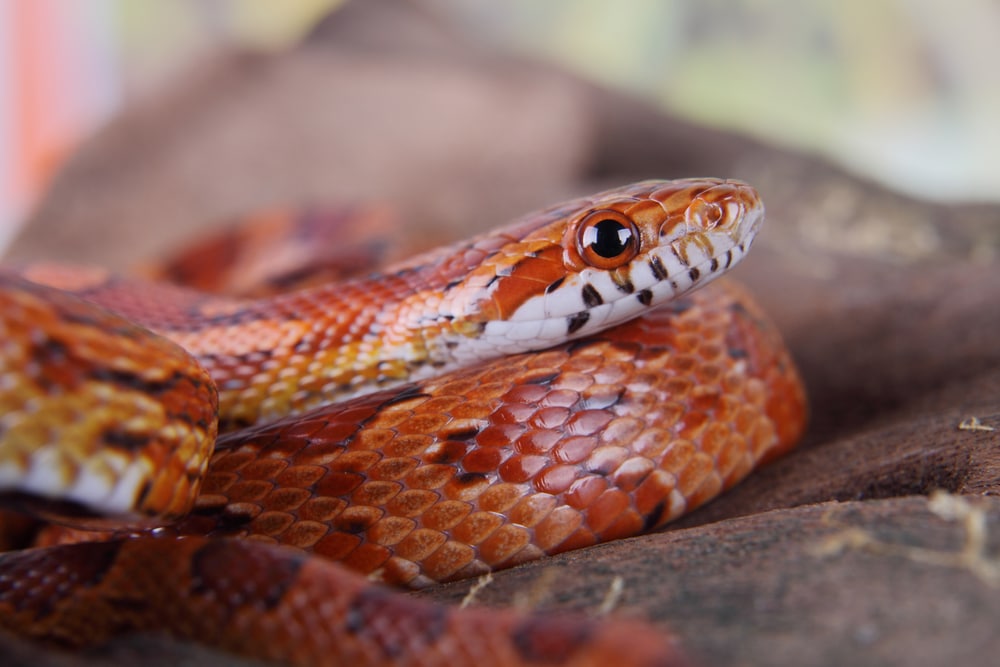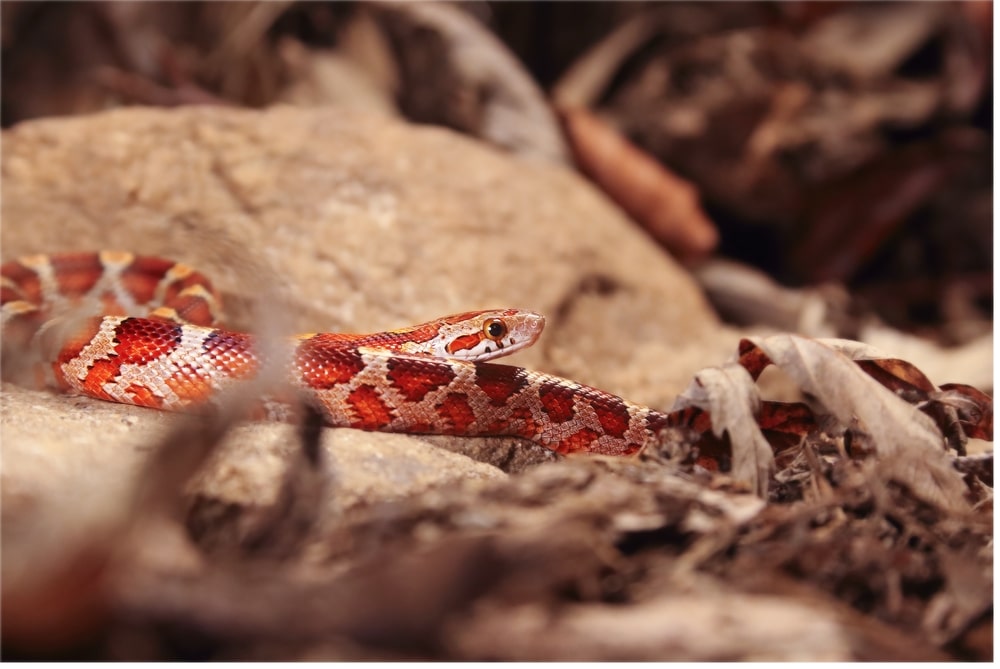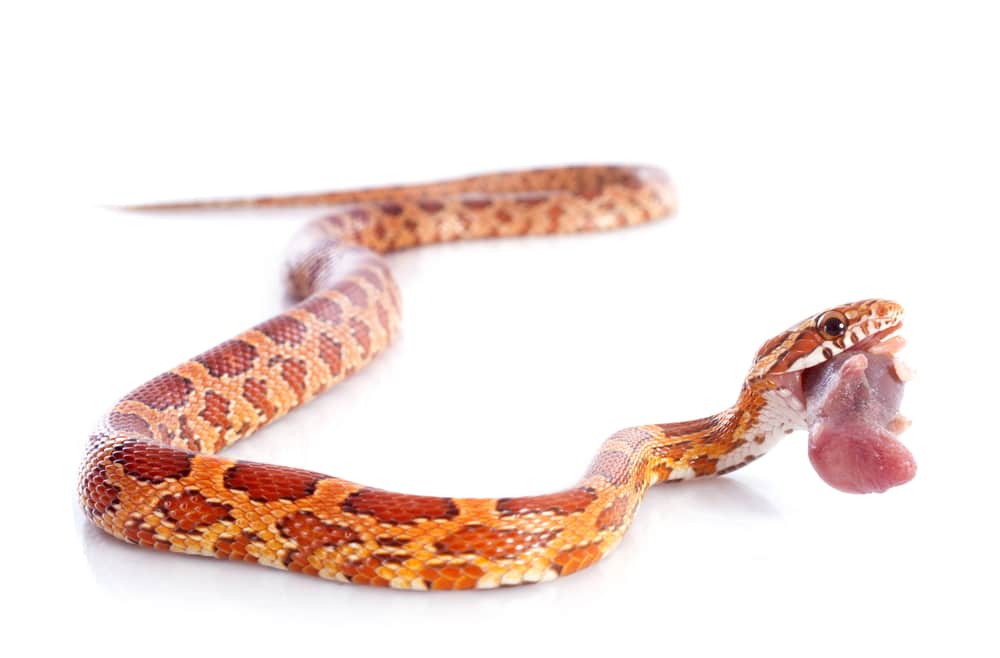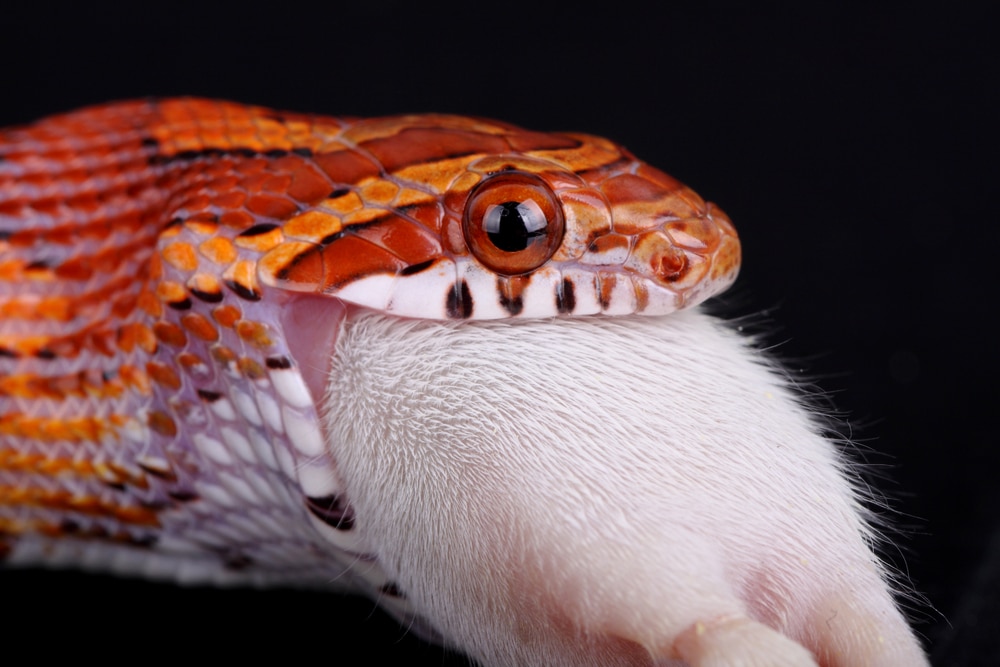Hardy animals with relaxed temperaments and easy-to-satisfy husbandry requirements, corn snakes (Pantherophis guttatus) are often described as being one of – if not the – best snake species for beginners to maintain.
By and large, new keepers tend to find that corn snakes are, in fact, great snakes and serious husbandry challenges or health issues are relatively rare. Nevertheless, there is one key aspect of corn snake care that may give beginners fits: feeding their new pet.

To be clear, most corn snakes are eager eaters, who don’t typically cause the kind of feeding challenges some other popular snakes do – but the entire snake-feeding process is a bit alien for many first-time keepers, which can make things more difficult than they’d otherwise be.
But don’t worry – we’re here to help.
Below, we’ll explain everything you need to know about feeding corn snakes, from prey selection to presentation technique, and we’ll also answer some common questions beginning corn snake keepers often have.
Quick Navigation
Basics of the Corn Snake Feeding Process

We’ll dive deep into the details of feeding corn snakes in a moment, but we’ll begin by simply outlining the process. This will help ensure you know what to expect moving forward.
- You’ll start by picking out a food item for your snake. It’ll usually be a frozen mouse or rat, but some snakes may demand different prey or prey that is still alive.
- After thawing the prey item, you’ll grip it with a pair of tongs.
- You’ll open the habitat and place the prey item in front of your snake’s face.
- Your snake may strike the prey item immediately, or it may take him a little while to decide to do so.
- Once the snake strikes the prey item, release your grip on it with the tongs.
- At this point, your snake will likely coil around the prey item and “constrict” it for a little while.
- Try to back away slowly and close the enclosure.
- Watch your snake from afar to ensure everything goes according to plan without spooking him.
- Wash your hands.
That’s all there is to it. It may take you a while to complete the feeding process at the beginning, but with practice, you’ll learn to do so very quickly.
Prey-Selection for Corn Snakes
In the wild, corn snakes are pretty opportunistic predators, who eat a variety of prey species. This typically includes lizards, frogs, rodents, birds and eggs, but they may also consume other snakes or insects from time to time.
However, in captivity, it is typically wisest to feed your corn snake a rodent-based diet.
Rodents are a healthy, easily obtained food source, and they’re also more affordable than some other potential food items.
Prey Size
Be sure to select rodents of the appropriate size for your snake.
As a rule of thumb, you’ll want to select feeder rodents that are about 1.25 times the size of your snake at midbody – it should create a subtle, yet distinct bulge in your snake’s body.
There is nothing dangerous about selecting a rodent that is smaller than this, but doing so over time may leave your snake without enough calories to grow or maintain proper body weight.
On the other hand, prey items that are too large may cause your snake to vomit them back up, and rarely, it may lead to serious internal injuries.
You’ll have to gradually increase the size of the prey you offer as your snake grows.
Every snake is an individual, and you should always use the guidelines discussed above to select prey of the appropriate size, but hatchlings will typically require newborn (“pink”) or fuzzy mice, while large adults may be able to consume medium-sized rats.

Captive corn snakes are capable of catching, subduing and killing live rodents, but it is important to understand that rodents often fight back – this can cause your snake to suffer very serious injuries.
Accordingly, it is wiser to offer your snake frozen-thawed rodents. This also eliminates any suffering on the part of the rodent.
Preparing Your Corn Snake’s Food
After selecting a food source of the right size, you’ll need to begin preparing it for your snake.
If you are planning on feeding your snake a live rodent, you’ll need to start by thawing it. The best way to do so is by simply setting it out on a thick layer of paper towels in a relatively warm location.
Do not offer it to your pet until the rodent has thawed completely and is soft to the touch.
If you must expedite the process, you can place the rodent in a jar of warm (not hot) water. Never try to thaw a rodent in a microwave – doing so doesn’t work very well and it may result in a mess of unthinkable proportions if you accidentally leave it inside for too long.
If you intend to feed your snake a live rodent, be sure that it is well-fed (this will help reduce the chances of the rodent viewing your snake as potential food) and clean off any substrate, urine or feces on its fur.
Presenting Your Corn Snake’s Food
If you are feeding your snake a live rodent, you can simply open the enclosure and place the rodent inside. Be sure to be aware of your snake while doing so and avoid waving your hands near his face – he may mistake your hand for a rodent and strike.

Be sure to monitor your snake until he has captured and consumed the rodent and be ready to intervene immediately if the rodent starts biting your pet.
It is also important that you inspect your snake’s enclosure afterward, so that you can remove any feces he produces while inside the snake cage.
If you are feeding a thawed rodent to your pet, begin by grabbing it around the body with a long pair of feeding tongs or tweezers. Gently open the enclosure door and move the rodent in front of your snake’s face.
If your corn snake is an aggressive feeder, he may go ahead and strike and begin constricting the rodent (snakes often constrict dead prey just as they would do with live prey).
However, if your snake is not a particularly aggressive feeder, you may need to “animate” the rodent a bit by moving it around. This will help give the rodent the appearance of being alive, which may be necessary for some snakes.
Once the snake has struck the food item, release your grip on the rodent, close the enclosure door and slowly back away. Observe your snake from afar to avoid spooking him.
Feeding Frequency for Corn Snakes
Now that you have determined the proper prey size for your snake, you’ll need to figure out a good feeding schedule for your pet.
There are no hard-and-fast rules regarding feeding frequencies for corn snakes, but a once-per-week schedule is typically a good starting point.
Nevertheless, you’ll need to monitor your snake’s body condition and be ready to make adjustments as necessary.
If, for example, your snake does not appear to be growing at a reasonable rate, you may want to feed him every fifth day rather than once every seven.
Conversely, if your snake appears to be putting on excess body weight (which is typically only a problem with mature individuals), you’ll want to cut back on the feeding frequency a bit.
Mature animals who are healthy will usually maintain a good body weight if fed once every 10 to 14 days.
Note that some snakes, especially males, may refuse food during the winter. This is no cause for concern, and most animals who engage in seasonal fasts will readily begin feeding again once spring arrives.
Finally, remember that an ideal feeding frequency for your snake will also depend on the size of the rodents you offer him.
If you feed your snake large rodents, you’ll likely need to feed him slightly less frequently. Conversely, if you tend to feed your snake relatively small prey items, you may find it necessary to increase the frequency with which you offer him food to ensure he maintains good body weight.
Tips and Tricks for Reluctant Feeders
Corn snakes are generally easy snakes to feed – that’s part of the reason that they make good pets for beginners. However, they may occasionally present feeding difficulties, which can prove very frustrating.
Don’t worry – there are a number of things you can do to help convince your pet to eat. Some of the most effective solutions are explained below.
- Don’t worry if your snake refuses food. Snakes have evolved the ability to survive for extremely long periods of time between meals. It would take weeks, if not months, for a healthy corn snake to starve to death. Accordingly, you’ll want to avoid panicking if your snake refuses a meal – simply discard the refused rodent and try to feed your snake again a few days later.
- Make sure your snake’s enclosure is set up properly. Many feeding difficulties can ultimately be traced to poor husbandry or habitat-design. So, anytime your snake refuses more than one meal, you’ll want to double-check your pet’s habitat and review your husbandry procedures. Check everything but pay special attention to the temperatures in the enclosure and ensure that your snake has a good hiding space.
- Reduce the amount of time spent handling your snake. Excessive handling may cause corn snakes to become stressed, which may lead them to refuse food. Typically, corn snakes do not seem to mind regular handling, but it is wise to cover all your bases when dealing with a reluctant feeder.
- Try feeding your snake when it is dark. Corn snakes shift their activity patterns for a variety of reasons, but they’re typically diurnal (day-active) snakes. Nevertheless, some keepers find that their snake exhibits a stronger feeding response when offered food in low-light conditions. Just remember to monitor your snake during the feeding process, if you are offering a live rodent; never leave a live rodent with your snake overnight.
- Experiment with dark or multi-colored rodents. Corn snakes are rarely picky about the rodents they consume, but some – particularly wild-caught individuals – may prefer to eat rodents that resemble wild rats and mice, rather than the often-all-white laboratory rodents sold as feeders. So, if your snake doesn’t appear interested in the rodents you’re offering, try to find some grey, multi-colored or black rodent for his next feeding.
- Place your snake and a frozen-thawed rodent in a small container together. For reasons that defy understanding, some snakes appear far more likely to eat when placed in a very small container with a frozen-thawed prey item. If you’ve been unable to coax your snake into eating in dark conditions and naturally colored rodents haven’t proven helpful, this is a good trick to try.
- Consider using scent-transfer techniques. Snakes primarily rely on their sense of smell when identifying food. This means that you can often trick them into eating a prey item by making it smell like something else. The best way to do so is by simply rubbing a lizard, frog or bird on a frozen-thawed rodent.
- Experiment with different prey species. If nothing else works, you may want to try offering your pet something besides a rodent. Birds, lizards and frogs are the prey items that are most likely to trigger your snake to feed, but hamsters, gerbils and other “pet” rodents may be worth trying too.
- Have your vet examine your pet if the fast persists for longer than one month. While husbandry errors, seasonal fasts and prey preference issues are likely the cause of most feeding difficulties, health problems can also cause a snake to refuse food. So, make an appointment with your vet and have your pet examined if you can’t entice him to feed within a month’s time.
Conclusion
There’s certainly a lot that beginners must learn about feeding corn snakes, but you’ll likely be surprised at just how easy the process usually unfolds. Just don’t panic if your snake presents some difficulties during your initial feeding trials.
Take your time, work through the tips and tricks provided earlier, and you’ll likely achieve success.